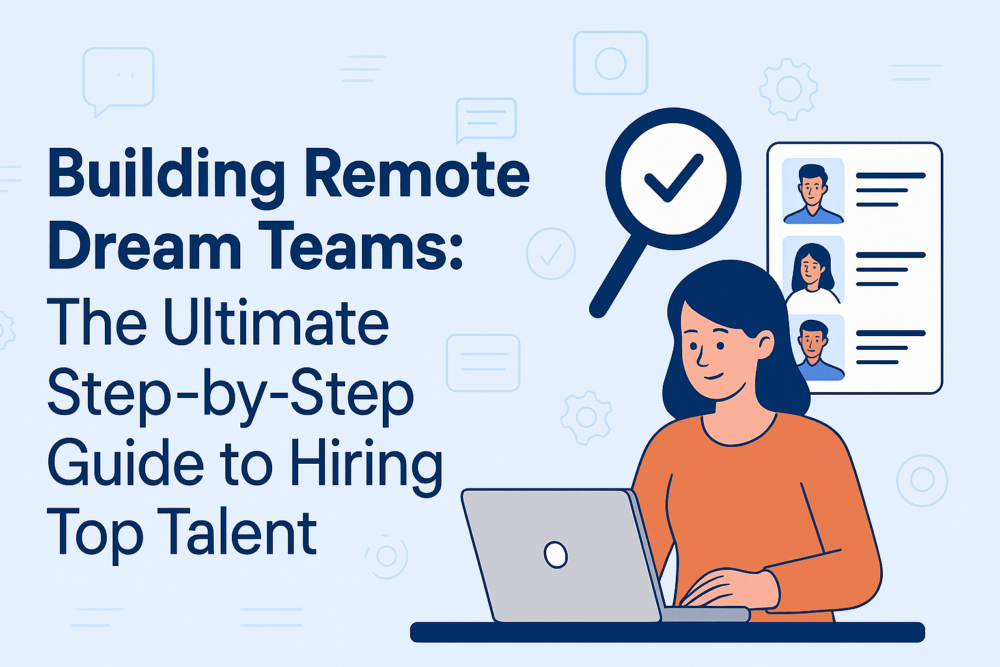Hiring remote talent has transformed from a growing trend to a strategic necessity for modern businesses. With companies embracing flexible work arrangements and tapping into global talent pools, knowing how to hire remote professionals effectively can determine whether a business thrives or merely survives. In this detailed guide, we offer proven strategies and actionable tips for hiring remote talents who align with your goals.
- Understanding the Need for Remote Talent
Remote work isn’t just a perk—it’s a business advantage. It gives companies access to global skills, reduces overhead costs, and increases productivity. But hiring remote talent comes with its own set of challenges: communication, accountability, and engagement. Before you dive into recruitment, understand why you need remote talent and how it fits into your long-term strategy.
Moreover, identifying the roles best suited for remote work allows you to plan the recruitment process effectively. Not all positions require physical presence, and recognizing the flexibility in job functions sets the tone for efficient hiring.
- Crafting a Clear Remote Job Description
The job description is the first point of contact between you and potential candidates. It should be transparent, detailed, and tailored specifically for remote positions. Outline not just the responsibilities and qualifications but also the expected working hours, communication tools used, and team dynamics.
In addition, highlight your company’s remote culture. Candidates want to know how your organization supports distributed teams. Addressing this up front attracts talents who are aligned with your work environment.
- Choosing the Right Hiring Platforms
To hire talents remotely, you must go where remote professionals are. Traditional job boards may not deliver the same quality as platforms dedicated to remote work. Websites like We Work Remotely, Remote OK, Toptal, and ScaleUp365 give you access to pre-vetted, skilled professionals looking for remote roles.
You should also consider industry-specific platforms or talent networks. Choosing the right channel helps filter candidates better and saves time in the long run.
- Screening Candidates Effectively
Initial screening should assess both technical capabilities and remote-readiness. Look for candidates who can demonstrate previous remote work experience or show traits necessary for successful virtual collaboration, such as self-motivation and clear communication.
To streamline this, implement structured screening forms, video responses, or task-based tests. These not only highlight candidate skills but also how they perform under limited guidance—an essential trait for remote work.
- Conducting Remote Interviews with Precision
Remote interviews require more than just jumping on a video call. Start with a clear structure—define what you want to learn and prepare a consistent set of questions. Use platforms like Zoom or Google Meet, and test your setup beforehand.
Focus on more than technical fit. Ask behavioral questions and explore how candidates manage their time, deal with distractions, and contribute to remote culture. This is a golden opportunity to evaluate their communication style and tech proficiency.
- Assessing Technical and Soft Skills
Use case studies or mini-projects to test real-world scenarios. Ask candidates to solve tasks they would face on the job, and observe how they approach the problem and communicate their solution.
- Verifying References and Work Histories
Remote roles demand a balanced mix of hard and soft skills. While evaluating technical expertise is straightforward, don’t neglect traits like adaptability, emotional intelligence, and independent problem-solving.
One of the most overlooked tips to hire remote talent is thoroughly checking references. Ask past employers or clients about the candidate’s remote work ethic, reliability, and communication style.
Additionally, review their work history in-depth. LinkedIn recommendations, project portfolios, and GitHub profiles (for developers) are great sources to validate claims. A well-documented track record boosts confidence in your hiring decision.
- Offering Competitive and Transparent Compensation
Remote hiring means competing on a global scale. To hire talents effectively, offer competitive compensation adjusted for location, skills, and experience. Don’t underpay just because someone is in a low-cost region—top talent knows their worth.
Be transparent about pay, benefits, work hours, and performance expectations. Transparency fosters trust and helps avoid surprises that can derail onboarding.
- Building a Seamless Onboarding Process
Your onboarding process sets the stage for your new hire’s success. For remote employees, it’s even more critical to make them feel included and supported. Create a welcome kit, introduce them to team members, and provide training resources.
Assign a mentor or buddy to guide them through their first few weeks. This small investment significantly increases engagement and retention, especially when hiring remote professionals.
- Encouraging a Culture of Communication and Accountability
Once you hire remote talents, your job isn’t done. Building a thriving remote team requires intentional communication and a strong culture. Use tools like Slack, Notion, or Asana to stay connected and aligned on goals.
Set expectations around responsiveness, meeting cadences, and performance metrics. Encourage openness, celebrate wins, and regularly check in to maintain morale and productivity.
- Evaluating Performance and Retention Over Time
Remote teams need continuous improvement. Use KPIs and feedback loops to evaluate the performance of your remote hires. Track productivity, quality of output, and team satisfaction.
If gaps appear, offer training and support instead of reacting with quick replacements. Retaining skilled remote talent is far more efficient than going back to the hiring board.
Final Thoughts: Hiring Remotely the Smart Way
In an era where flexibility, agility, and global outreach are critical, knowing how to hire remote talent effectively gives your business a competitive edge. From job postings to onboarding and retention, each step in the hiring journey plays a crucial role.
By following this structured, thoughtful approach and leveraging the best platforms and tips for hiring remote talents, you position your company to attract and retain world-class professionals who drive growth and innovation.
